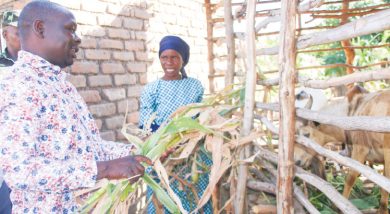Biogas for smokeless cooking
Turkeys gobble, chickens cluck, pigs grunt and goats bleat while cows moo and chew.
The farmhouse of Yohane and Virginia Chaoloka in Chimtengo Village, Dedza North, is a cacophony of animals that offer more than just meat, milk, money and manure.
The cows offer them something families in the rural setting can only envy.
You say prestige, they say no. You say an inheritance, they say maybe. You say gas for cooking, they say yes, yes, yes!
“The cows are almost everything,” says Virginia. “They produce milk for sale and our diet. We don’t throw away dung, but turn it into gas for cooking.”

The biogas from dung has liberated her from long walks in search of firewood in Dzenza Hill and she no longer cooks in a kitchen choked with smoke and soot.
In the village, six pieces of firewood—which burn out after cooking three meals, a day’s routine—sell at K200.
“Gas from dung is all clean. You just strike a matchstick and it burns. The blue flame cooks faster than firewood. No coughs. No sneezing. No waiting,” she says.
The biogas plant, installed by Vuna Africa in recognition of the dairy farmers’ dedication to climate-smart farming, reduces Virginia’s exposure to pneumonia, tuberculosis and other respiratory diseases resulting from unclean cooking energy.
About 3 billion people globally—40 percent of the world’s population—suffer devastating risks of not using clean fuel and technologies for cooking, according to the 2018 Energy Progress Report launched in May at the Sustainable Energy for All Forum in Portugal.
“Household air pollution from the use of inefficient stoves paired with charcoal, firewood, coal and kerosene are responsible for some four million deaths a year,” reads the report on Sustainable Development Goal (SDG) seven: sustainable energy for all by 2030.
In Malawi and other countries left behind in energy access, many women and girls die softly while cooking.
The silent crisis kills 13 000 people a year in Malawi, reports the Ministry of Health.
“If the current trajectory continues, 2.3 billion people will continue to use traditional cooking in 2030, perpetuating much of the current negative health, environmental, climate and development impacts,” says World Bank energy specialist Vivien Foster.
But the need for rapid deployment of clean cooking fuels and technologies has not received the attention it deserves from policymakers.
“It lags well behind the rate of electrification in almost every country, even in spite of the smaller costs needed to ensure clean cooking solutions for all compared to electrification,” says Foster.
In Malawi, about 10 percent of the population is connected to the grid—but only one percent of those with electricity access use electricity for cooking, according to the National Statistics Office.
As such, up to 97 percent of the population use charcoal and firewood, putting forests up in smoke and exposing people to health hazards
After a decade of keeping cattle, the Chaolokas have been saved by the smokeless cow dung.
Every day, they empty a wheelbarrow of dung into a paved pit. They stir it like porridge. The liquid flows into a sceptic tank to ferment, emitting biogas for a smoke-free burner in Virginia’s kitchen and solid waste into a manure pit.
“With biogas, I spend more time in my shop instead of fetching firewood or coughing,” she says.
To onlookers, this is a big breakthrough.
“They are saved from buying firewood,” says Melina Mbewe.
Lilongwe University of Agriculture and Natural Resources (Luanar) trained the farmers how to rear cattle and produce manure and nutritious feed using locally available materials.
Chopping and mixing cattle feed, Yohanne said a Jersey cow that once produced eight litres of milk a day now offers over 20 litres.
“Milk is profitable. We have bought an ox-cart and oxen for hire. We acquired a plot where we have built three houses for rent. Now our children go to good private school worth K100 000 per term. But biogas is a big saving,” he counted the gains.
The family has stopped growing tobacco which they describe “too demanding”.
“It requires a lot of attention everyday, but the earnings are seasonal and nothing much. Growers often complain about low prices and high deductions. With milk production, I work fewer hours a day and make more money,” he narrates.
Enthused by the “fire from dung”, they heap cattle dung carefully.
And organic manure is improving fertility, sponginess and moisture retention of their three-acre crop field of maize, soya and groundnuts.
The Chaolokas’ yield is increasing amid effects of drought and climate change. With almost 1.9 million families in the country facing food shortage, they have surplus.
“With manure, we harvested over 200 bags weighing 50 kilogrammes from a two-acre maize field where we once yielded 45 bags after using 10 bags of fertiliser,” he recalls.
“The good news is that manure from biogas production is ready in just three days instead of 35,” says Luanar-based livestock scientist Donald Kazanga
To Cabmacc lead investigator Liveness Banda said the family exemplifies how proper livestock management enhances livelihoods by increasing milk production and reducing gas emissions that cause global warming
“Our study in Dedza show daily milk production per cow has increased from almost 4.5 litre to 12 litres, manure use is improving yields and the emissions that cause global warming are falling. Most importantly, those who use biogas no longer deplete forests and suffer effects of kitchen smoke.”





